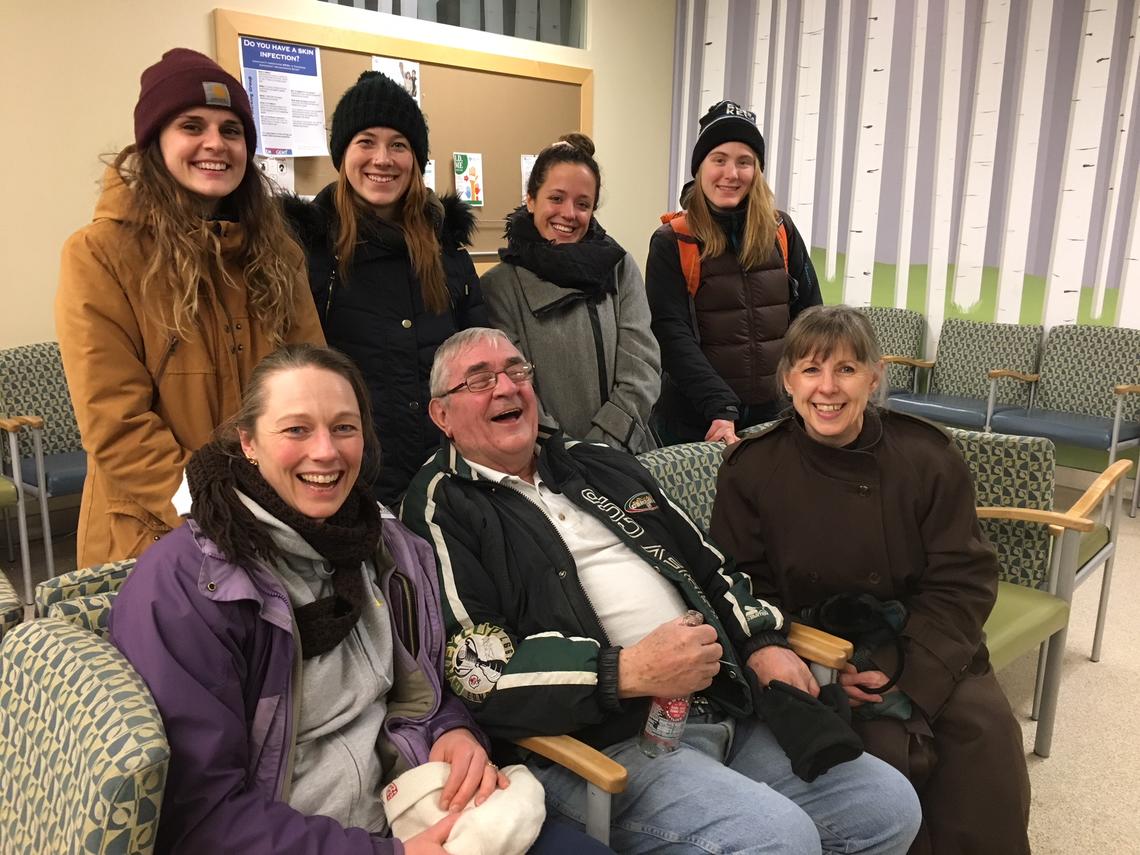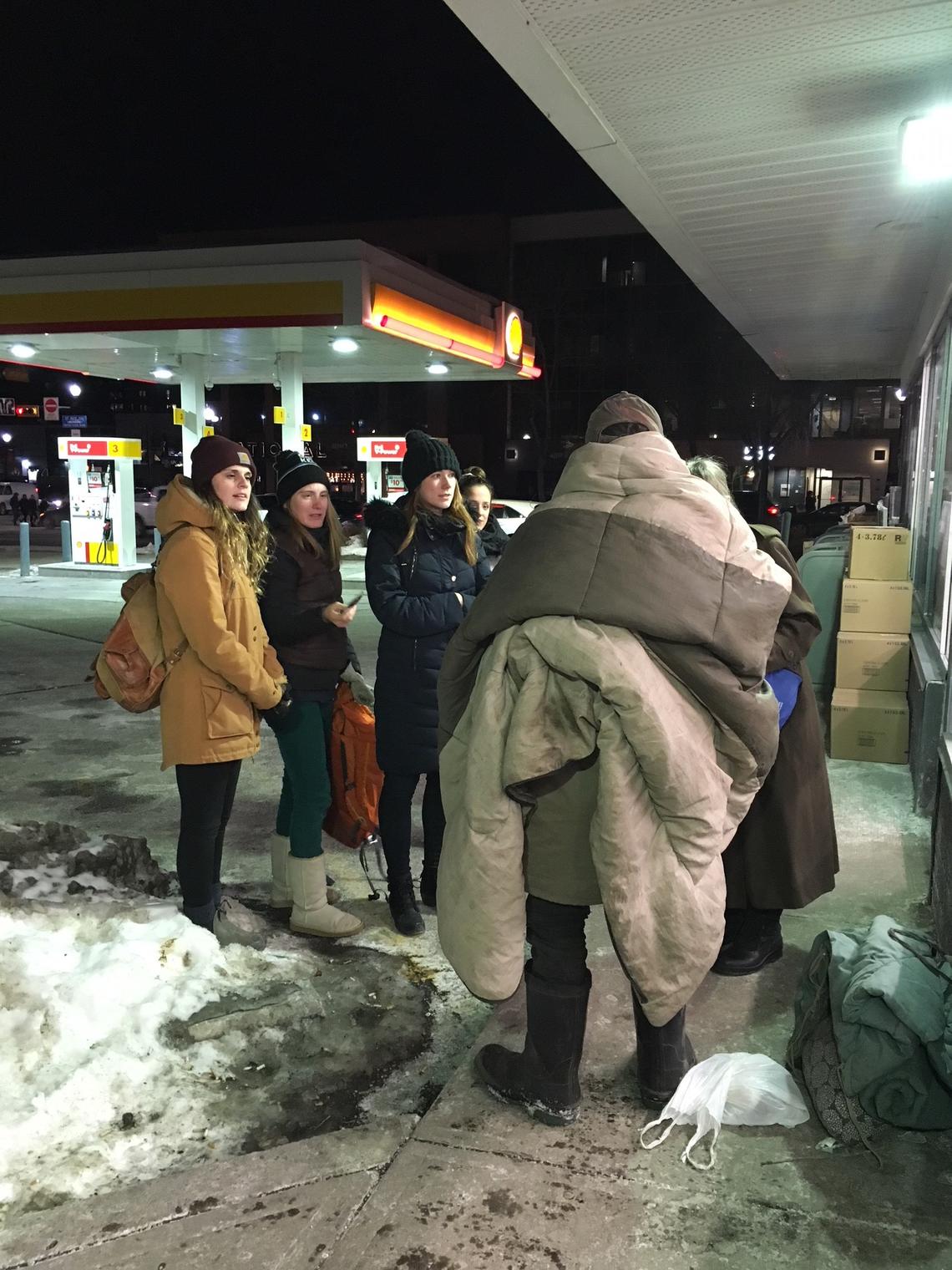May 30, 2019
Homeless people tell nursing students, 'Just treat us like human beings'

Nursing students prepare to "walk the streets" with former homeless man, John Bodman.
Faculty of Nursing photos
It wasn’t the coldest night in our seemingly endless Calgary winter, but the crisp air could still penetrate the warmest parkas, the frozen ground, and even the most insulated boots. As four second-year nursing students from the University of Calgary trudged down 17th Avenue S.W. on a frigid February evening, the weather brought into even sharper focus the predicament of Calgary’s homeless.
Pictured above are students preparing to "walk the streets" with former homeless man, John Bodman (seated, centre) and assistant professor Candace Lind (seated, right). The students (standing) from left are Sam Whitaker, Kirstine Carlson, Gabrielle Tarratt and Hannah van Varseveld. Seated Kara Levis, friend of Bodman.
The students were participating in an extracurricular activity that associate professor Candace Lind, RN, PhD, offers to those in her community health theory course. Strictly voluntary, the walk allows the students a first-hand look at what they are examining in class: the real-life effects of the social determinants of health including the pain of poverty, stigma, addiction and mental health. This particular night is the fourth for Lind this month and what she sees on these walks doesn’t change.
“We teach about this in class, but coming face-to-face with the reality of it is something else,” Lind says. “The invisibility of it — because you can walk down the street and not even see it — is revealed. We ask questions like, ‘What do you want these student nurses to know about how to treat homeless people?’ or ‘Tell us how can nurses help you.’ Probably the answer we get most often is ‘Just treat us like human beings.’”
Accompanying the students on their walk and, in fact, initiating and then smoothing the way for safe conversations with some of Calgary’s most vulnerable people, is John Bodman, a former homeless man, who overcame an addiction to crack-cocaine and now works to help others facing what he did 10 years ago.
“I wasn’t a bad guy, I just made bad choices,” explains Bodman. “What turned me around was the thought that I didn’t want a cop going to my daughter’s door telling her that her dad was dead. If I kept going like I was, that was going to be what happened.”

Students meet "Kevin," who lives on Calgary's streets.
Faculty of Nursing
Bodman leads the students across 12 blocks of 17th, stopping the occasional person and asking them if they want to chat. Some do, some don’t and on this particular evening, the students learn just as much from those who speak to them as from those who do not.
One man declines to talk, but takes the warm socks offered and removes his shoes to reveal bare feet. Another eats a fruit cup, turning down a granola bar because he is missing teeth. He confides to the group that he has been on his own since he was eight years old. He is now 49.
“It’s very lonely out here,” he says. “I have learned to look after myself best I can, but it is very lonely.” His answer to how nurses can earn his trust? “Be kind and listen,” he responds.
For student Samantha Whitaker, 17th Avenue will never look quite the same. “This amazing experience was a real eye-opener,” she says. “I loved having the opportunity to chat with the individuals who were living on the street as it ultimately confirmed my belief that they are just like everyone else. If anything, they are more resilient — an attribute I believe should be respected and celebrated. This, unfortunately, does not seem to be the case in society.”
“I tell my large lecture class everyone deserves to be treated with dignity and respect,” Lind says. “But when they hear this directly from a person living on the streets, it’s a way more powerful message than I can give my students. This is profound learning that will stay with them forever.”
